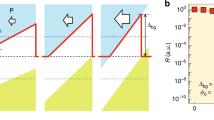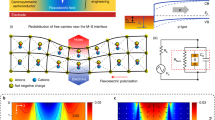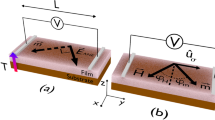Abstract
Flexoelectricity is a property of all dielectric materials whereby they polarize in response to deformation gradients such as those produced by bending1,2,3,4,5. Although it is generally thought of as a property of dielectric insulators, insulation is not a formal requirement: in principle, semiconductors can also redistribute their free charge in response to strain gradients. Here we show that bending a semiconductor not only generates a flexoelectric-like response, but that this response can in fact be much larger than in insulators. By doping single crystals of wide-bandgap oxides to increase their conductivity, their effective flexoelectric coefficient was increased by orders of magnitude. This large response can be explained by a barrier-layer mechanism that remains important even at the macroscale, where conventional (insulator) flexoelectricity otherwise tends to be small. Our results open up the possibility of using semiconductors as active ingredients in electromechanical transducer applications.
This is a preview of subscription content, access via your institution
Access options
Subscribe to this journal
Receive 51 print issues and online access
$199.00 per year
only $3.90 per issue
Buy this article
- Purchase on Springer Link
- Instant access to full article PDF
Prices may be subject to local taxes which are calculated during checkout




Similar content being viewed by others
References
Kogan, S. M. Piezoelectric effect during inhomogeneous deformation and acoustic scattering of carriers in crystals. Sov. Phys. Solid State 5, 2069–2070 (1964)
Bursian, E. & Zaikovskii, O. I. Changes in curvature of ferroelectric film due to polarization. Sov. Phys. Solid State 10, 1121 (1968)
Tagantsev, A. K. Piezoelectricity and flexoelectricity in crystalline dielectrics. Phys. Rev. B 34, 5883–5889 (1986)
Cross, L. E. Flexoelectric effects: charge separation in insulating solids subjected to elastic strain gradients. J. Mater. Sci. 41, 53–63 (2006)
Zubko, P., Catalan, G. & Tagantsev, A. K. Flexoelectric effect in solids. Annu. Rev. Mater. Res. 43, 387–421 (2013)
Ma, W. & Cross, L. E. Flexoelectricity of barium titanate. Appl. Phys. Lett. 88, 232902 (2006)
Catalan, G. et al. Flexoelectric rotation of polarization in ferroelectric thin films. Nat. Mater. 10, 963–967 (2011)
Lee, D. et al. Giant flexoelectric effect in ferroelectric epitaxial thin films. Phys. Rev. Lett. 107, 057602 (2011)
Lu, H. et al. Mechanical writing of ferroelectric polarization. Science 336, 59–61 (2012)
Tagantsev, A. K. & Yurkov, A. S. Flexoelectric effect in finite samples. J. Appl. Phys. 112, 044103 (2012)
Stengel, M. Microscopic response to inhomogeneous deformations in curvilinear coordinates. Nat. Commun. 4, 2693 (2013)
Stengel, M. Surface control of flexoelectricity. Phys. Rev. B 90, 201112 (2014)
Hong, J. & Vanderbilt, D. First-principles theory of frozen-ion flexoelectricity. Phys. Rev. B 84, 180101 (2011)
Sinclain, D. C., Adams, T. B., Morrison, F. D. & West, A. R. CaCu3Ti4O12: one-step internal barrier layer capacitor. Appl. Phys. Lett. 80, 2153–2155 (2002)
Glaister, R. M. Barrier-layer dielectrics. Proc. IEE Part B 109, 423–431 (1962)
Von Hippel, A. Dielectrics and Waves (Artech House, 1995)
O’Neill, D., Bowman, R. M. & Gregg, J. M. Dielectric enhancement and Maxwell–Wagner effects in ferroelectric superlattice structures. Appl. Phys. Lett. 77, 1520–1522 (2000)
Catalan, G. & Scott, J. F. Magnetoelectrics: is CdCr2S4 a multiferroic relaxor? Nature 448, E4–E5 (2007)
Damjanovic, D., Demartin Maeder, M., Duran Martin, P., Voisard, C. & Setter, N. Maxwell–Wagner piezoelectric relaxation in ferroelectric heterostructures. J. Appl. Phys. 90, 5708–5712 (2001)
Kolodiazhnyi, T. et al. Thermoelectric power, Hall effect, and mobility of n-type BaTiO3 . Phys. Rev. B 68, 085205 (2003)
Heywang, W. Semiconducting barium titanate. J. Mater. Sci. 6, 1214–1226 (1971)
Genenko, Y. A., Hirsch, O. & Erhart, P. Surface potential at a ferroelectric grain due to asymmetric screening of depolarization fields. J. Appl. Phys. 115, 104102 (2014)
Lee, S. & Randall, C. A. Determination of electronic and ionic conductivity in mixed ionic conductors: HiTEC and in-situ impedance spectroscopy analysis of isovalent and aliovalent doped BaTiO3 . Solid State Ion. 249–250, 86–92 (2013)
Morozovska, A. N. et al. Thermodynamics of electromechanically coupled mixed ionic-electronic conductors: deformation potential, Vegard strains, and flexoelectric effect. Phys. Rev. B 83, 195313 (2011)
Poumellec, B., Marucco, J. F. & Lagnel, F. Electron transport in Ti1–xNbxO2 solid solutions with x < 4%. J. Phys. Chem. Solids 47, 381–385 (1986)
Narvaez, J., Saremi, S., Hong, J., Stengel, M. & Catalan, G. Large flexoelectric anisotropy in paraelectric barium titanate. Phys. Rev. Lett. 115, 037601 (2015)
Biancoli, A., Fancher, C. M., Jones, J. L. & Damjanovic, D. Breaking of macroscopic centric symmetry in paraelectric phases of ferroelectric materials and implications for flexoelectricity. Nat. Mater. 14, 224–229 (2015)
Garten, L. M. & Trolier-McKinstry, S. Enhanced flexoelectricity through residual ferroelectricity in barium strontium titanate. J. Appl. Phys. 117, 094102 (2015)
Haertling, G. H. Rainbow actuators and sensors: a new smart technology. Proc. SPIE 3040, 81–92 (1997)
Berlincourt, D. & Jaffe, H. Elastic and piezoelectric coefficients of single-crystal barium titanate. Phys. Rev. 111, 143–148 (1958)
Damjanovic, D. Ferroelectric, dielectric and piezoelectric properties of ferroelectric thin films and ceramics. Rep. Prog. Phys. 61, 1267–1324 (1998)
Kaneda, K. et al. Kinetics of oxygen diffusion into multilayer ceramic capacitors during the re-oxidation process and its implications on dielectric properties. J. Am. Ceram. Soc. 94, 3934–3940 (2011)
Müller, A. & Härdtl, K. H. Ambipolar diffusion phenomena in BaTiO3 and SrTiO3 . Appl. Phys. A 49, 75–82 (1989)
Muller, D. A., Nakagawa, N., Ohtomo, A., Grazul, J. L. & Hwang, H. Y. Atomic-scale imaging of nanoengineered oxygen vacancy profiles in SrTiO3 . Nature 430, 657–661 (2004)
Yang, G. Y., Dickey, E. C., Randall, C. A., Randall, M. S. & Mann, L. A. Modulated and ordered defect structures in electrically degraded Ni–BaTiO3 multilayer ceramic capacitors. J. Appl. Phys. 94, 5990–5996 (2003)
Lee, A. A., Colby, H. H. & Kornyshev, A. A. Statics and dynamics of electroactuation with single-charge-carrier ionomers. J. Phys. Condens. Matter 25, 082203 (2013)
Chan, N.-H., Sharma, R. K. & Smyth, D. M. Nonstoichiometry in undoped BaTiO3 . J. Am. Ceram. Soc. 64, 556–562 (1981)
Acknowledgements
This research was funded by an ERC Starting grant from the EU (ERC 308023) and by a national research grant (FIS2013-48668-C2-1-P) from the Spanish MINECO. All research in ICN2 is supported by the Severo Ochoa Excellence Programme (SEV-2013-0295). F.V.-S. thanks MICITT and CONICIT for support during his PhD. We thank D. Torres for the illustration in Fig. 1. Belarre for help with sample polishing and B. Ballesteros for help with the EELS measurements shown in Methods.
Author information
Authors and Affiliations
Contributions
J.N. and G.C. conceived the idea and analysed the results. J.N. and F.V.-S. performed the experiments. G.C. wrote the paper.
Corresponding author
Ethics declarations
Competing interests
The authors declare no competing financial interests.
Additional information
Reviewer Information Nature thanks E. Eliseev, N. Mathur, D. Vanderbilt and the other anonymous reviewer(s) for their contribution to the peer review of this work.
Extended data figures and tables
Extended Data Figure 1 Effective flexoelectric coefficients of semiconducting crystals of Nb-doped TiO2 (0.05%Nb by weight) as a function of sample thickness.
The red line is a linear fit to the data.
Extended Data Figure 2 EELS analysis.
Top, EELS spectra of a cross-sectional sample of BaTiO3, measured in a transmission electron microscope. There is no monotonic trend as a function of distance to the surface, so no indication that the surface (at least to a depth of 1.4 μm) is any more (or less) oxidized than the bulk. A comparison with the shape of the EELS spectra of SrTiO3−δ (bottom-left; image reproduced from ref. 34, Macmillan Publishers Limited) or BaTiO3−δ (bottom-right; reprinted from ref. 35, with the permission of AIP Publishing) is consistent with δ ≤ 0.14 for our crystals.
Extended Data Figure 4 Conductivity of BaTiO3−δ.
Total conductivity σ = σelectron + σion measured across the capacitor structure.
Extended Data Figure 5 Flexoelectricity of undoped TiO2 and Nb-doped TiO2.
The conducting Nb-doped sample (right) displays an effective flexoelectricity that is >2,000 times larger than the insulating sample (left). Note that the units are nC m−1 and μC m−1 for TiO2 and Nb-TiO2 respectively.
Rights and permissions
About this article
Cite this article
Narvaez, J., Vasquez-Sancho, F. & Catalan, G. Enhanced flexoelectric-like response in oxide semiconductors. Nature 538, 219–221 (2016). https://doi.org/10.1038/nature19761
Received:
Accepted:
Published:
Issue Date:
DOI: https://doi.org/10.1038/nature19761
This article is cited by
-
Size-dependent effect of the flexoelectronics in a composite beam
Acta Mechanica (2024)
-
Flexo-photocatalysis in centrosymmetric semiconductors
Nano Research (2024)
-
Electro-mechanical responses of transversely isotropic piezoelectric nano-plate based on the nonlocal strain gradient theory with flexoelectric effect
Acta Mechanica (2023)
-
Flexoelectricity-enhanced photovoltaic effect in trapezoid-shaped NaNbO3 nanotube array composites
Nano Research (2023)
-
Highly heterogeneous epitaxy of flexoelectric BaTiO3-δ membrane on Ge
Nature Communications (2022)
Comments
By submitting a comment you agree to abide by our Terms and Community Guidelines. If you find something abusive or that does not comply with our terms or guidelines please flag it as inappropriate.



